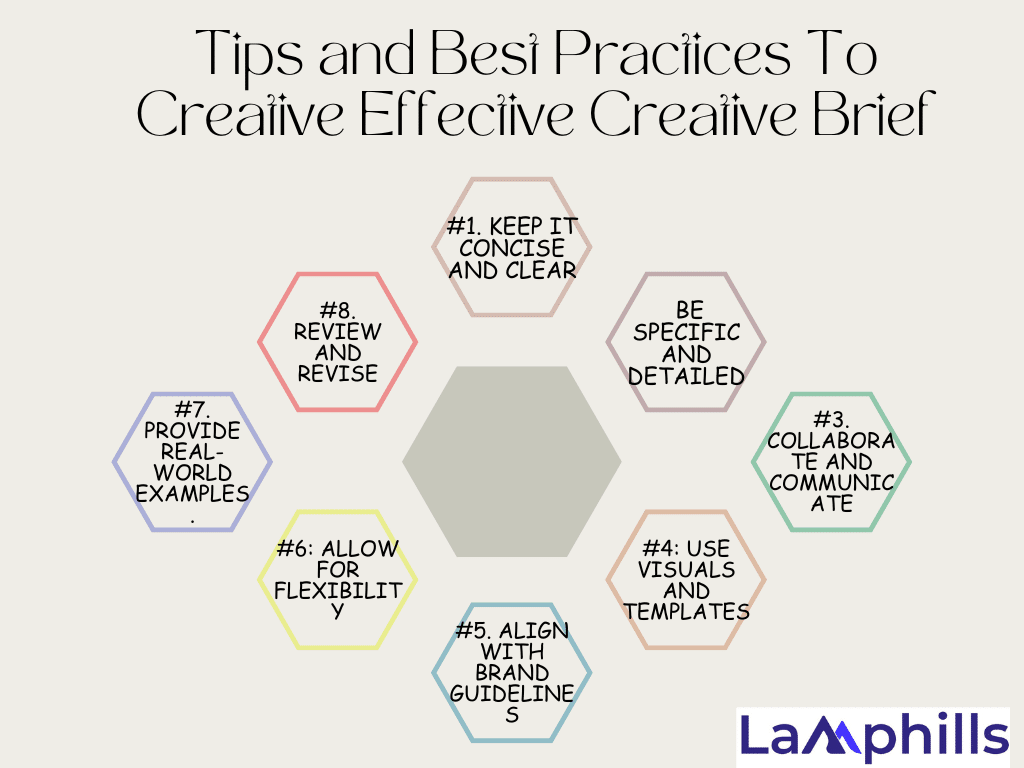Have you ever been involved in a project that seemed to fall off course, like constantly needing to help the team with understanding the client’s vision or the end goal? My first major endeavor without a creative brief remains imprinted in my memory. It was the debut of eco-friendly water bottles, and despite our initial joy, the project swiftly devolved into shambles.
In the end, we missed deadlines, went through numerous modifications, and the final campaign fell short. It could have been more organized, but it showed me the value of a well-crafted creative brief. Not to ever be in our situation, in this article, I will discuss why a creative brief is necessary, break down its important components, and walk through a step-by-step approach to constructing one.
Key Takeaways
- A creative brief serves as a roadmap, guiding your team through the project’s objectives, audience, key messages, tone, deliverables, timeline, and budget. It provides a clear direction and ensures everyone is on the same page.
- Each element—from project overview to target audience, key message, tone and style, deliverables, and specifications—plays a crucial role in creating an effective and comprehensive brief.
- Keeping your brief concise and clear, being specific, collaborating with your team, using visuals, aligning with brand guidelines, allowing for flexibility, reviewing, and using real-world examples are all best practices that enhance the quality of your creative brief.
- Avoiding vagueness, ensuring clear objectives, considering the budget, aligning with brand guidelines, and defining deliverables are essential to preventing common pitfalls.
What is a Creative Brief?

A creative brief is a document that defines the project’s important components and serves as a road map for everyone involved. It addresses the project’s objectives, target audience, key message, tone and style, deliverables, timetable, and budget. Without a defined brief, initiatives can easily get off track, wasting time and resources.
Think of a creative brief as a project’s GPS. It ensures that everyone involved in the project, including designers, writers, marketers, and stakeholders, understands its goals and how to achieve them. A proper brief keeps the project on track, much as a well-planned road trip map assures that you get to your goal without deviation. A well-structured creative brief achieves three main goals:
- Compatible with Team Vision and Goals: Everyone understands what they’re working for.
- Maintains message consistency across all platforms.
- Saves time and resources by avoiding costly modifications and miscommunication.
Key Elements of a Creative Brief

A well-crafted creative brief is similar to the foundation of a house. If it is strong, everything constructed upon it will be strong. Let’s look at the main components of a creative brief, each of which is critical to the success of your project. I’ll also share some personal experiences and examples to illustrate their importance.
#1. Project Overview
Think of the project overview as an executive summary of your creative brief. It lays the groundwork for everything that follows. This section should give a quick overview of the project and explicitly state its aims and goals.
For example, in a campaign I worked on to launch a new fitness app, our project summary included:
- Description: Begin a campaign for “FitLife,” a complete fitness app.
- Objective: Increase app downloads by 40% within the first three months.
- This overview provided everyone involved with a brief perspective of our goals, allowing us to align our efforts from the outset.
#2. Target Audience
Understanding your target audience is similar to understanding your destination on a map. It guides all of your messages and creative decisions. This section should provide thorough demographic and psychographic information about your target audience.
Throughout the FitLife campaign, we developed detailed personalities. One of our key identities was:
- Hannah is health-conscious.
- Age: 28
- occupation: marketing Professional
- interests include yoga, a healthy diet, and digital devices.
Knowing who we were talking to allowed us to adapt our message to Health-Conscious Hannah and others like her.
#3. Key Message
Your key message is the heart of your creative brief. It’s the core idea you want your audience to remember. This message should be clear, concise, and compelling.
For FitLife, our key message was:
- “Transform your fitness journey with personalized workouts and meal plans.”
This message encapsulated the app’s unique value proposition and guided all our content creation efforts, from social media posts to email newsletters.
#4. Tone And Style
The tone and style section defines the voice of your campaign. Is it formal or casual? Playful or serious? This ensures consistency across all communication channels.
For FitLife, we decided on a tone that was:
- Friendly and Motivational: We wanted to come across as a supportive friend encouraging users on their fitness journey.
I remember one social media post that perfectly captured this tone: “Hey FitLifers! Ready to crush your fitness goals today? Let’s get moving with our new HIIT workout – you’ve got this!”
#5. Deliverables And Specifications
This section outlines what needs to be created and any specific requirements. It could include everything from social media graphics to blog articles to video content.
For FitLife, our deliverables included:
- 10 Instagram posts (JPEG)
- 5 Blog articles (1,000 words each)
- 3 Promotional videos (MP4)
Being specific about the formats and quantities helped keep the team on track and ensured we met all our content needs.
#6. Timeline And Budget
I once worked on a project that lacked a clear timeline. We had an excellent creative concept for a Christmas marketing campaign for an internet store. However, because we did not establish clear timelines for each stage, we ended up hurrying to complete everything at the last minute. The stress level was considerable, and the quality of the final content degraded. Since then, I’ve consistently highlighted the necessity of a well-planned timeframe in my creative briefs.
In other words, a defined timeframe and budget are required to keep the project on track and within financial constraints. This section should include critical milestones and dates, as well as the amount of money allotted to each component of the project. For the FitLife campaign, our timeline looked something like this:
- Week 1-2: Market research and audience persona development
- Week 3-5: Content creation
- Week 6-7: Content review and approval
- Week 8-12: Campaign launch and monitoring
Also, our funding was divided across content production, social media advertising, and influencer collaborations. Finally, remember to examine and amend your creative brief. Collect input from all stakeholders and make changes as necessary. This phase ensures that everyone is on the same page and that the brief is as detailed and straightforward as feasible. Whether you’re introducing a new product, rebranding, or planning a marketing campaign, understanding these factors can help you generate effective and powerful creative briefs.
Steps to Crafting an Effective Creative Brief
Creating a creative brief can be challenging, but breaking it down into simple phases makes the process easier and more efficient. To do this,
#1. Decide on a Name for the Project
The first step in creating a creative brief is selecting a project name. This may sound easy, but it is one of the most important aspects of a creative brief. If you’re creating a campaign for a brand-new product or service, the campaign name will be the first time many members of your team hear about it. Referring to the campaign (and thus the product or service) by its proper name prevents the game of telephone from occurring. Without a precise and obvious campaign name, people will make up their vocabulary, which may affect the campaign’s aim.
Keep your project or campaign name original and brief when developing it. A few words or a short sentence should be sufficient. If you’re launching a product, figure out what the target audience’s call to action will be and base the name around that. Here are a few examples of imaginary campaign names.
- The Search for Adventure Campaign- A scavenger hunt-themed amusement park.
- The Don’t Forget Your Memories Campaign – A photo frame company.
- The “What’s hotter than Pepperco hot sauce?” Campaign – A hot sauce brand.
#2. Provide an Overview
Next, prepare a generic project overview for team members to utilize as a quick reference. This section should briefly describe the problem, aim, and deliverables. Even though the overview comes toward the beginning of the creative brief, you may want to write it last, after you’ve detailed the remainder of the document.
#3. Research and Gather Information
This means that, before you can draft a creative brief, you must collect all essential facts. This includes performing market research, assessing the competitive landscape, and soliciting feedback from stakeholders.
For example, when we worked on the FitLife app campaign, our first step was to undertake extensive market research. We examined existing fitness applications, their features, and user evaluations. We also interviewed potential customers to learn about their fitness objectives and pain points. This research yielded useful insights that helped design our campaign strategy.
#4. Define Clear Objectives
Our goal for one campaign was excessively broad: “Improve brand awareness.” Without a clear goal, it was difficult to quantify our performance, and the team struggled to find direction. Since then, I’ve made it a point to ensure that our objectives are SMART.
Therefore, your objectives should be Specific, Measurable, Achievable, Relevant, and Time-bound (SMART). Clear objectives provide guidance and aid in measuring the success of your campaign.
For example, for the FitLife app, we wanted to “increase app downloads by 40% within three months.” This goal was concrete, measurable, and time-bound, providing us with a clear direction to work towards.
#4. Identify the Target Audience
Understanding your target audience is critical. This entails developing thorough audience personas that cover demographics, psychographics, requirements, and preferences. The next step is to establish the project’s target audience. This is the market segment that will profit directly from the newly announced product or service. You can expand audience segmentation by defining a primary and secondary audience. This allows your team more opportunity to experiment with unique ideas that may appeal to one group more than another. When creating the target audience section, remember to include the following:
- Demographics – Simple demographic information gives your team insight into exactly who the audience is. This includes data points like age, income, education, ethnicity, and occupation.
- Behaviors – Buying behaviors, trends, and other customer histories make up the target audience behaviors. These provide important context to the creative brief because they explain where the customer is in their buyer journey.
- Psychographics – This is how the audience thinks and feels about your brand and the product or service you sell, in general.
- Geographics – Digital, physical, and hybrid campaigns will benefit from having geographics stated explicitly in the creative brief so that media buyers can price ad slots in each market.
#5. Develop the Core Message
The core message can be the most challenging aspect of the creative brief to produce because nearly every stakeholder will have a different idea of what it should be. This easy strategy will help you get buy-in faster. Take for instance: “We’re launching this project, so what?” The “so what?” is your primary message. It describes why your target audience should pause their current activities and focus on your campaign.
That is, the essential message comprises the pain point, what the audience’s experience would be like if the pain point did not exist, and the benefit they will gain as a consequence of your solution. This structure puts the client at the forefront of the marketing instead of informing them what this product or service can accomplish for them, it casts them as the protagonists in the journey from problem to solution.
#6. Specify the Deliverables and Formats
To establish the project’s scope, specify the deliverables that will result from the marketing or advertising campaign. For example, it could result in a television commercial, a website, or a series of search engine advertisements. So, clearly define what needs to be generated, including formats and requirements. This prevents uncertainty and ensures that all team members understand what is expected.
#7. Set the Tone and Style
The tone and style of your material should be consistent with your brand’s identity and relevant to your target audience. Define the tone as professional or casual, playful or serious. Next, talk about the tone of voice that the creative materials should utilize to reach the target audience. For example, the tone might be warm and friendly or blunt and honest, depending on what may appeal better to the intended viewer.
#8. Outline the Timeline and Budget
A clear timeline and budget are essential to keep the project on track and within financial limits. This section should detail key milestones, deadlines, and budget allocations.
Example: For FitLife, our timeline included:
- Week 1-2: Market research and audience persona development
- Week 3-5: Content creation
- Week 6-7: Content review and approval
- Week 8-12: Campaign launch and monitoring
Our budget was divided between content creation, social media advertising, and influencer partnerships.
#9. Share the Creative brief with Stakeholders
Once you’ve created a creative brief, share it with the team you’ll be working with. You’ll also want to distribute it throughout the workplace via Slack, email, or presentations. If you’re a consultant working outside of a client’s organization, encourage them to disseminate the brief internally.
#10. Review and Revise
It is critical to thoroughly review and revise your creative brief. Then collect feedback from stakeholders and make any required changes to ensure clarity and completeness. Keep in mind that each phase in generating a creative brief is critical to establishing a clear, focused, and effective project roadmap.
Creative Brief Template
Get started with this creative brief template to outline your campaign goals, creative deliverables, due date, marketing strategy, and more.
Tips and Best Practices To Creative Effective Creative Brief

Creating a creative brief requires both art and science. Over the years, I’ve learned a lot from both my triumphs and, more significantly, my failures. Here are some tried and true strategies and best practices to help you build a strong and effective creative brief.
#1. Keep It Concise and Clear
A creative brief should be precise enough to help your team while remaining simple and easy to understand. Avoid jargon and keep your terminology plain and straightforward.
For example, the FitLife marketing short was simply three pages long but contained all the necessary information. This made it straightforward for everyone to understand the project’s scope and objectives.
#2: Be Specific and Detailed
While being concise, be specific. Vague instructions might cause confusion and variable results. Clearly state what you want and expect. For instance, rather than stating “create social media content,” indicate “create 10 Instagram posts and 5 Facebook posts, each with a caption, hashtag set, and image size of 1080×1080 pixels.”
#3. Collaborate and Communicate
Engage your staff in the briefing process. This is because collaboration can introduce new viewpoints and ideas, resulting in a well-rounded brief. Keep open channels of communication to answer any inquiries or concerns.
#4: Use Visuals and Templates
Visual aids can make your brief more entertaining and understandable. Use templates to maintain consistency and save time. Diagrams, charts, and sample images can help you demonstrate your views.
#5. Align with Brand Guidelines
Make sure your brief is consistent with your brand’s overarching identity and rules. Brand integrity requires consistent tone, style, and messaging across all endeavors.
For FitLife, we used the brand’s style guide to keep the tone welcoming and motivating throughout all materials. This uniformity helps to strengthen the brand’s identity across all of our communications.
#6: Allow for Flexibility
While detail and specificity are vital, there is also room for creativity and flexibility. When creative professionals are allowed to explore ideas, they frequently produce their greatest work.
#7. Provide Real-World Examples
Include real-world examples in your brief to assist define your vision. Show samples of earlier work that is relevant to your current project to provide a concrete reference. For example, in the FitLife brief, we incorporated effective social media efforts from similar apps. These examples helped the team understand the style and quality we aimed for.
Finally, by carefully practicing these strategies, you’ll be well-equipped to create briefs that set your projects up for success.
#8. Review and Revise
Always examine your brief before submitting it. Gather input from stakeholders and team members, and make the necessary changes. This phase ensures that your brief is clear, comprehensive, and error-free.
Common Mistakes to Avoid When Crafting A Creative Brief

Making a creative brief can be difficult, and it’s simple to make mistakes that can jeopardize your project. Here are some frequent dangers to look out for,
#1. Being Too Vague
One of the most prevalent errors is not providing enough information. An unclear brief can cause misunderstanding, misplaced expectations, and poor results.
In one of my early assignments, we were entrusted with developing a social media campaign for a new product. Our brief was simply, “Create engaging content for social media.” Due to a lack of specificity, our team members’ opinions varied greatly, resulting in uneven and inefficient material.
#2: Ignoring the Audience
Failure to adequately define and understand your target audience might lead to material that does not resonate with those you want to reach.
#3. Overloading with Information
While detail is vital, providing too much information in your brief can overwhelm your team and conceal the key issues.
For example, I incorporated pages with background information, facts, and charts in a website makeover project. The brief was so comprehensive that team members struggled to discover the necessary information, resulting in delays and dissatisfaction.
#4. Lack of Clear Objectives
Without clear, detailed objectives, your team will lack direction, making success difficult to quantify. For example, in a newsletter subscription campaign, we aimed to “increase engagement.” This ambiguous purpose made it difficult to assess progress and determine success. We later refined our goal to “increase newsletter subscriptions by 20% over the next three months,” which provided a more specific target and emphasis.
#5. Not Considering the Budget
Ignoring budget limits might lead to unrealistic plans that cannot be implemented as intended. For example, for a video marketing campaign, we developed a thorough strategy without taking into account the budget. Halfway through, we learned the expenses were substantially beyond our budget, causing us to significantly reduce the project’s scope and impact.
#6. Failing to Align with Brand Guidelines
Ignoring brand guidelines might result in discrepancies that degrade your business’s identity. For example, in a rebranding campaign, we originally ignored existing brand rules. The resulting content had an inconsistent tone and visual style, which confused our consumers and undermined the brand’s identity.
#7. Failing to Define Deliverables and Formats
Without clear definitions of deliverables and formats, your team may create content that does not meet the project’s requirements.
For example, a digital marketing campaign’s brief merely stated “content.” The team generated a variety of content, but not what was required. Specifying “5 blog posts (1,000 words each), 10 social media posts (JPEG), and 3 video ads (30 seconds each)” would have avoided the confusion.
#8: Skipping the Review Process
Not evaluating and modifying your creative brief can result in blunders and miscommunications. For example, we bypassed the review phase due to tight timelines on one project. The brief contained numerous inaccuracies, including inaccurate dates and missing important material. This caused uncertainty and difficulties throughout execution.
When do you need a creative brief?
Any marketing project requiring the development of creative aspects and coordination amongst various stakeholders needs a creative brief. Also, if your small business’s marketing team collaborating with an agency to design and oversee a holiday social campaign? A creative brief is something you will need.
What are the 3 main sections of a creative brief?
The objective, the audience, and the message.
How many pages is a creative brief?
A creative brief should ideally be one page, with a maximum of two pages, as PayPal’s sample below illustrates. Here are some best practices for crafting an excellent creative brief along with a more thorough look at what should be included.
How long should it take to write a creative brief?
It only takes 30 minutes or less to complete. (Yes, you can take longer, of course, but you don’t have to.)
Conclusion
An effective creative brief demands a combination of rigorous research, clear communication, and strategic thinking. It’s all about understanding the project’s objectives, knowing your audience, and offering clear, practical instructions to your team.
So, the next time you start a project, take a moment to consider these processes and suggestions. Then craft your brief with care, and your projects will operate more smoothly and successfully. In the end, the time and effort you spend on developing a detailed creative brief will be rewarded for the quality and efficacy of the final product.
References
- wordstream.com
- blog.hubspot.com
- indeed.com
- asana.com
- plaky.com






